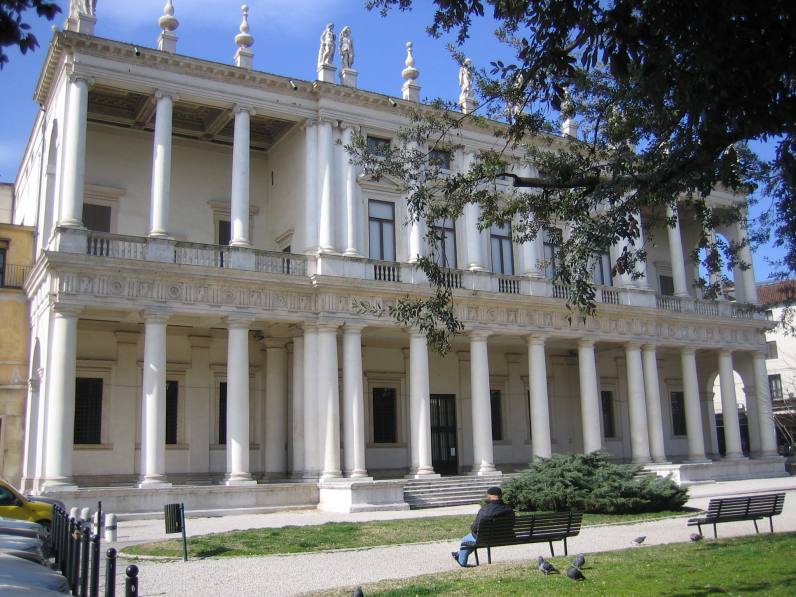Andrea Palladio
(November 30, 1508 – August 19, 1580), was an Italian
architect, widely considered the most influential person in the history of
Western architecture.
He was born Andrea di Pietro della Gondola in Padua, then
part of the Republic of Venice. Apprenticed as a stonecutter in Padua when he
was 13, he broke his contract after only 18 months and fled to the nearby town
of Vicenza. Here he became an assistant in the leading workshop of stonecutters
and masons. He frequented the workshop of Bartolomeo Cavazza, from whom he
learned some of his skills.
His talents were recognized in his early thirties by Count
Gian Giorgio Trissino, who also gave him the name Palladio, an allusion to the
Greek goddess of wisdom Pallas Athene. In 1541 he moved to to study
classic architecture.
Palladio designed many churches, villas, and palaces,
especially in Venice, Vicenza and the surrounding area. A number of his works
are protected as part of the World Heritage Site Palladian Villas of the
Veneto.
Chronology
1508: Born in Padua on 30 November
1521: Begins work as a stone mason
1540: Begins his first work, Villa Godi in Lonedo
1544: Begins construction of Villa Pisani in Bagnolo
1545: Involved in the refurbishment of the Basilica of Vicenza
1550: Produces drawings for Palazzo Chiericati and Villa Foscari
1552: Begins work on Villa Cornaro and the palace of Iseppo De' Porti
1554: Begins work on Villa Barbaro in Maser
1556: In Udine he works on Casa Antonini and in Vicenza begins with Palazzo Thiene. While his assignments increase along with his fame, he collaborates with the patriarch of Aquileia on the edition of a book on Vitruvio, providing the drawings.
1557: Begins Villa Badoer in the Po river valley
1558: Realises a project for the church of San Pietro di Castello in Venice and probably in the same year begins the construction of Villa Malcontenta
1559: Begins Villa Emo in the village of Fanzolo di Vedelago
1561: Begins the construction of Villa Pojana Maggiore and at the same time of the refettorio for the Benedictines of St. George in Venice, and subsequently the facade of the monastery Monastero per la Carità and Villa Serego
1562: Begins the facade of San Francesco della Vigna and work on San Giorgio Maggiore
1565: Begins the construction of Villa Cagollo in Vicenza and Villa Pisani in Montagnana
1566: Palazzo Valmarana and Villa Zeno
1567: Begins works for the Villa Capra "La Rotonda"
1570: He is nominated Proto della Serenissima (Illustrious citizen of Venice) and publishes in Venice I Quattro Libri dell'Architettura (The Four Books of Architecture)
1571: Realises: Villa Piovene, Palazzo Porto Barbaran, the Loggia del Capitanio and Palazzo Porto Breganze.
1574: Publishes the 'Commentari' (commentaries) of Caesar and works on studies for the front of the Basilica di San Petronio in Bologna
1577: Begins the construction of the Il Redentore
1580: Prepares drawings for the interior of the church of S. Lucia in Venice and in the same year on 23 March oversees the beginning of the construction of the Teatro Olimpico but dies on 19 August 1580
Villa Capra "La Rotonda" in Vicenza.
Inside of Villa Capra "La Rotonda" in Vicenza.
The Teatro Olimpico ("Olympic Theatre"),
Vicenza
Façade of Palazzo Chiericati in Vicenza
Palladio's work became well known after the publication of I
Quattro Libri dell'Architettura (The Four Books of Architecture) in 1570.
Interest in his style was renewed in later generations and became fashionable
all over Europe, for example in parts of the Loire Valley of France. In Britain,
Inigo Jones and Christopher Wren embraced the Palladian style. Another admirer
was the architect , 4th Earl of Cork, also known as Lord Burlington, who, with
William Kent, designed Chiswick House.
Thomas
Jefferson, 3rd President of the United States, also admired the work of
Palladio which served as inspiration for the University of Virginia and his
house at Monticello. In a letter written by Colonel Isaac A. Coles to General
Hartwell Cocke in 1816, Coles related that: "With Mr. Jefferson I conversed
at length on the subject of architecture—The Four Books of Architecture,
he said, 'was the Bible—you should get it and stick close to it...'"
You can find the above info at 




























